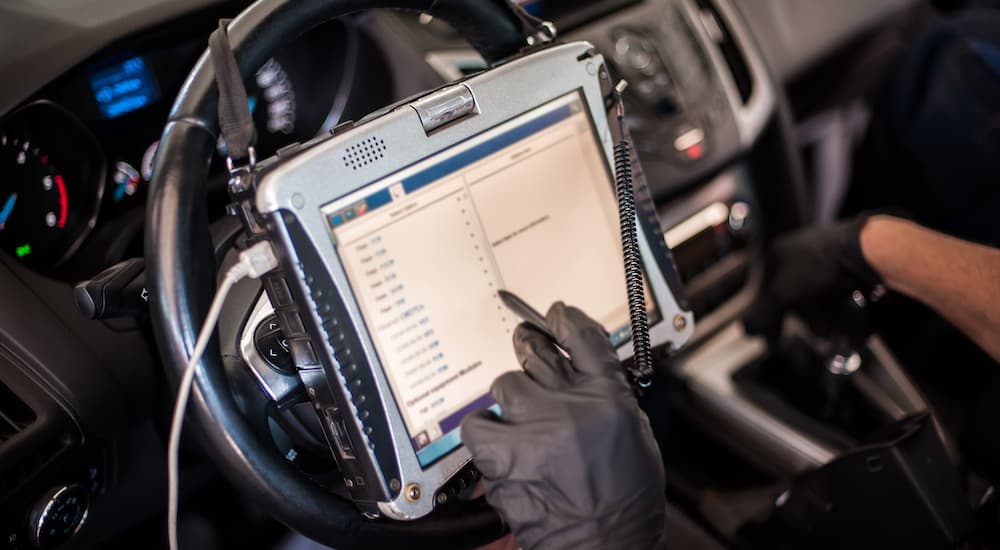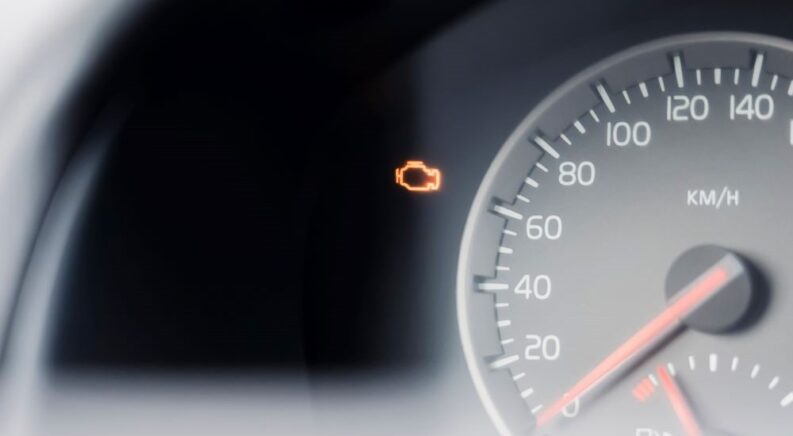If you don’t know a socket wrench from a tube sock, an illuminated check engine light might seem like the end of the world. That simple little icon can send some drivers spiraling and conjure images of pricey invoices from your local auto shop, but the truth is usually a little less dramatic. That’s not to say a check engine light isn’t serious––we did name our whole repair and maintenance blog after it––but it’s probably better to regard it as a form of vehicle-to-person communication rather than a signal of the automotive apocalypse. A check engine light is simply your vehicle’s way of pointing out a problem, ranging from the relatively minor to the potentially terminal. So, what should you do when faced with a check engine light? I’ll cover some of the basics of check engine light diagnostics, examine specific icons and their meanings, explain the inner workings of On Board Diagnostic II (OBD-II) scanners and diagnostic trouble codes (DTC), and review the steps a driver should take when faced with the dreaded icon.
Identify the Light
There’s no standard design for a check engine light, so it’s important to familiarize yourself with your vehicle’s specific icon before you find yourself trying to interpret automotive hieroglyphics as you speed down the highway at 70 mph. Most check engine lights are yellow or orange in color and stick to a pretty standard engine icon, while others simply feature the words “CHECK ENGINE” or “SERVICE ENGINE SOON.” Some lights might be a combination of the two with an engine icon paired with the word “CHECK” or “CHECK ENGINE.” There are two simple ways to acquaint yourself with the design of your check engine light. Every time you turn on your vehicle, your check engine light––along with a number of other warning lights––will stay illuminated for a short time before disappearing. This is your vehicle’s way of allowing you to check if any of the lights have burned out or malfunctioned, and it can be an easy way to get a look at the check engine icon. As always, your owner’s manual is another valuable resource, outlining the various warning lights used on your particular make and model. The manual will include an entry on the check engine light with a clear illustration of the design.
Solid vs Flashing/Red
Before breaking out an OBD-II scanner, visiting a local repair shop, or calling a tow truck, take a closer look at the check engine light itself. The check engine light might seem like a relative binary system––it’s either off, and everything is fine, or it’s on, and there’s cause for concern––but that’s not necessarily true. In order to help drivers assess the severity of the issue, automakers have designed check engine lights with two different modes. A solid check engine light that comes on and stays illuminated typically indicates a mechanical issue that should be dealt with sometime in the near future. Issues triggering a solid check engine light could be something as innocuous as a loose gas cap, oxygen sensor malfunction, or a minor vacuum leak, which, while not ideal, aren’t likely to end in a catastrophic failure. This doesn’t mean a solid check engine light should be ignored, but it does mean you have time to deal with the issue and don’t need to treat the light as a sort of emergency SOS. As long as you schedule an appointment with your mechanic or dealership and don’t take any cross-country road trips in the meantime, you’ll probably be fine.
A flashing check engine light is a different story altogether. When your check engine light comes on and then starts flashing, it can indicate a serious issue that requires immediate attention. Some vehicles might use a color-coded system instead of a solid/flashing system, with a yellow check engine light indicating a mild issue and a red check engine light pointing to a more severe problem. A flashing or red check engine light is most often triggered by an engine misfire caused by defective spark plugs or a malfunctioning ignition coil, which can result in some serious performance issues and even long-term damage if not quickly addressed. Other causes include an overheated engine, catalytic converter failure, or low oil pressure, which are all concerning in their own right. Low oil pressure, for example, means that the engine isn’t receiving the sort of lubrication it needs to work properly. A lack of lubrication can lead to friction, heat, and possibly even total engine failure and should never be taken lightly. When facing a flashing check engine light, pull off to the side of the road as quickly and safely as you can, shut off the engine, and call for roadside assistance. Continuing to drive a vehicle with a flashing check engine light can cause a fixable issue to spiral into a big-ticket repair in the blink of an eye, so it’s simply not worth taking the risk.

Perform a Quick Assessment
The check engine icon can send any driver into a panic. Unless you’re dealing with a flashing light, there’s usually no reason to assume the worst. While it can be the sign of a serious problem, it can also be the result of something fairly innocuous. For example, I once spent a couple of anxious moments at a highway rest stop trying to diagnose a check engine light, only to discover that it was the result of a loose gas cap. It turns out they don’t print that text about making sure you hear a clear “click” noise when tightening it down for no reason.
If the vehicle is running smoothly, you don’t notice any alarming smells or noises, and there’s no smoke emanating from underneath the hood, it’s time to turn your attention to the dashboard. The check engine light is just one of a half-dozen dashboard icons used to indicate an issue with various systems around the vehicle. The brakes, airbags, tire pressure monitoring system, traction/stability control, and even washer fluid often have their own dedicated lights, but when faced with a check engine light, it’s the coolant temperature, transmission temperature, and oil pressure warning lights that you want to keep an eye out for. If your check engine light is paired with any of these three lights, you might be dealing with at least a moderately severe issue that could require immediate intervention. Unless you’re fairly confident in your own automotive knowledge, don’t attempt to drive when your dashboard is lit up like a Christmas tree.
Get It Scanned
If the issue behind your check engine light isn’t severe enough to require an immediate tow, you have two choices on how to proceed. Those who prefer to delegate their auto inquiries to the pros can either visit their local mechanic/dealership or take their vehicle to an auto parts store. Most auto parts stores will perform a free diagnostic scan and should be able to provide a quick assessment of the issue, though they won’t be able to perform an actual fix. If the issue is relatively minor––something like a torn or loose hose, low fluid, or a dirty mass airflow sensor––they might be able to sell you a part that can be installed with relative ease from the comfort of your own driveway. If you’d rather take a more hands-off approach, simply make an appointment with your mechanic or dealership. If you have a good relationship with your dealership or mechanic, they might even perform the scan free of charge, but there’s no guarantee.
If you’re looking to diagnose the issue on your own and possibly even save a little money in the long term, consider investing in an OBD-II scanner. These handheld devices can be found online or at an auto parts store and basically act as a way to interpret what your vehicle is trying to tell you when it throws a check engine light. Onboard diagnostic systems have been required in new vehicles since 1996 and allow even the most mechanically challenged to quickly get a read on what sort of issue might be lurking under the hood. A standalone OBD-II scanner can be purchased for between $50 and $200, with fancier systems offering readings on various vehicle systems, along with relevant performance stats, but the smartphone era has also led to a new, even cheaper alternative in the Bluetooth OBD-II scanner. Available for as little as $20, these Bluetooth OBD-II scanners can be plugged into the OBD-II port located near the bottom-left of the steering wheel and interpreted through a smartphone-based app. These apps will interpret the DTC based on your make and model, can recommend a fix, and even help drivers gauge the severity of the issue and the potential cost to fix it.
How do OBD-II scanners work? Well, behind every check engine light, there is a diagnostic trouble code (DTC). These codes typically range between four and five characters and are composed of a letter followed by a three- or four-digit number starting with zero or one. The letter indicates which system triggered the code, while the first number points to a generic or manufacturer-specific code, and the remaining numbers identify the precise sub-system that’s affected. For example, a code that ranges between P0300 and P0305 usually indicates an engine misfire, with the last number pointing to the specific cylinder experiencing the misfire. A DTC like P0150 could indicate a faulty oxygen sensor, while a P0420 or P0442 would suggest a problem with the catalytic converter or leak in the evaporative emission control system respectively. These DTC codes vary slightly between vehicles, so before using an OBD-II scanner, it’s important to input the specific make and model. Most light- and medium-duty vehicles use the OBD-II standard for DTC code, but some heavy-duty models might employ the J1939 system.

Next Steps
Once you’ve found the specific DTC that triggered the check engine light, it’s time to do a little research. The internet can be helpful when it comes to assessing the severity of a DTC or the complexity of a repair, as can the OBD-II apps that come with most Bluetooth scanners. If you do want to tackle the project on your own, the check engine light can actually serve as a helpful tool to test the results. Perform the repair, whether it be replacing a spark plug or a hose or cleaning the mass airflow sensor, and then use the OBD-II scanner to clear the check engine light. If the light doesn’t pop back on within the next 10 to 15 miles of driving, chances are you’ve solved the issue, but if the light does kick back on, you might have some more work to do. Those without an OBD-II scanner can perform a more low-tech version of this trick that involves disconnecting the vehicle’s battery. This should automatically clear any DTC, though some of the more serious, permanent codes might resist this trick.
If your best efforts aren’t yielding any results, the problem seems beyond your abilities, or you simply don’t want to deal with the hassle, take your car to a trusted local mechanic or dealership. Provide them with any DTC you might have found when performing a scan, along with other relevant details about the mechanical issue or your vehicle’s performance. There’s no shame in throwing in the towel, especially when you consider the damage that can be incurred when you try to tackle a project that’s outside of your comfort zone.
Don’t Panic: You Know What to Do
A check engine light should never be taken lightly. It’s a very clear signal that there’s something amiss within the vehicle, whether it be something as minor as a loose gas cap or something as serious as a dangerously overheated engine. That said, I’d also recommend against overreacting. As long as there are no obvious signs of distress like a strange noise, smell, smoke, or a flashing/red icon, just think of the check engine light as a warning rather than an outright emergency. A quick scan can go a long way towards alleviating anxiety and helping to pin down the issue, which is why I would recommend every driver invest in an affordable OBD-II reader. Even if you’re not about to break out your coveralls and crawl under the car, knowing what sort of issue you’re dealing with can help narrow down the malfunction, assess repair costs, and know what sort of part or automotive specialist to seek out.

